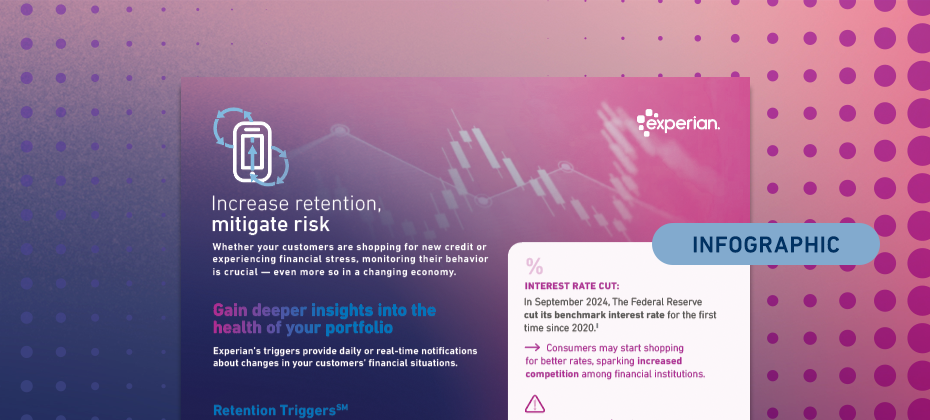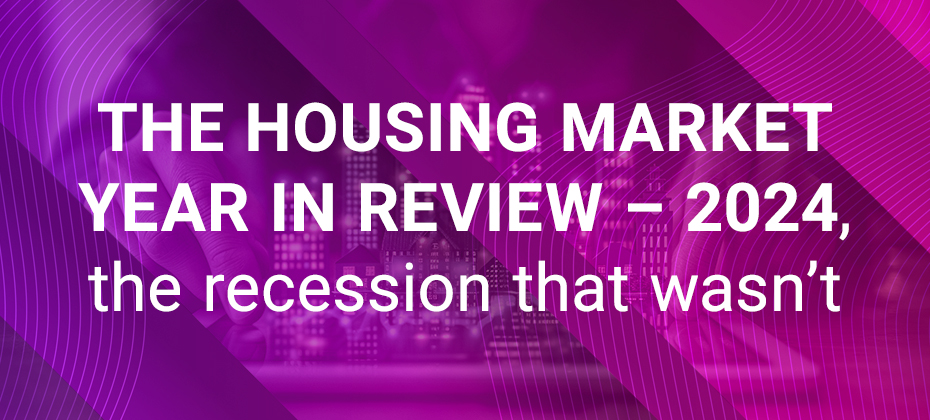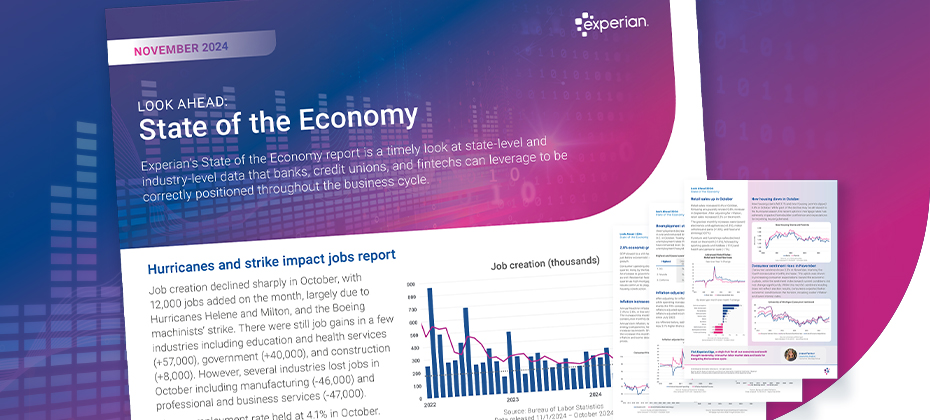Topics

Whether consumers are shopping for new credit or experiencing financial stress, monitoring their behavior is crucial — even more so in an ever-changing economy. Our latest infographic explores economic trends impacting consumers’ financial behaviors and how Experian’s Risk and Retention TriggersSM enable lenders to detect early signs of risk or churn. Key highlights include: Credit card balances climbed to $1.17 trillion in Q3 2024. As prices of goods and services remain elevated, consumers may continue to experience financial stress, potentially leading to higher delinquency rates. Increasing customer retention rates by 5% can boost profits by 25% to 95%. View the infographic to learn how Risk and Retention Triggers can help you advance your portfolio management strategy. Access infographic

In 2024, the housing market defied recession fears, with mortgage and home equity growth driven by briefly lower interest rates, strong equity positions, generally positive economic indicators, and stock market appreciation. This performance is notable because, in 2023, economists’ favorite hobby was predicting a recession in 2024. Following a period of elevated inflation, driven largely by loose monetary policy, expansionary fiscal policy, and supply chain disruptions brought on by COVID, economists were certain that the US economy would shrink. However, the economy continued outperforming expectations, even as unemployment rose modestly (Figure 2) and inflation cooled (Figure 3). Source: FRED (Figure 1, Figure 2, Figure 3). So, a good economy is good for the mortgage and home equity markets, right? Generally speaking, this statement was true. As monitored by Experian’s credit database, mortgage originations increased by approximately thirty percent year over year as of November 2024 (Figure 4), and Q3 ’24 pre-tax profit for Independent Mortgage Banks (IMBs) averaged $701 per loan.1 So, business in home lending is good — certainly better than it was during the period when the Fed was raising rates, origination volumes shrank as opposed to grew, and IMB profit per loan turned negative. Source: Experian Ascend Insights Dashboard. What constituted this growth in mortgage lending? As we all know, the Fed has lowered interest rates by 100bps since they started reducing rates in September. The market had priced in the September cut weeks prior to the actual announcement (Figure 5), and the market enjoyed a spike in refinance volume as a result (Figure 6). However, in the lead-up to and following the US presidential election, interest rates spiked back up due to the market’s expectations around future economic activity, which will dampen pressure on refinance volumes even after the recent additional rate drop. The impact of further rate drops on mortgage rates is unclear, and refinance volume still constitutes only around three percent of overall origination volume. Source: Figure 5, Figure 6 (Experian Ascend Insights Dashboard). The shift to a purchase-driven housing market What does this all mean? Our view is that pockets of refinance volume (rate and term, VA, FHA, cashout) are available to those lenders with a sophisticated targeting strategy. However, the data also very clearly indicates that this market is still very much a purchase market in terms of opportunity for originations growth. This position should not surprise long-time mortgage lenders, given that purchase volume has always constituted a significant majority of origination volume. However, this market is a different purchase market than lenders may be used to. This purchase market is different because of unprecedented statistics about the housing market itself. The average age of a first-time homebuyer recently reached a record high of 38. The average age of overall homebuyers in November of this year similarly jumped to a new record high of 56, with homes being “wildly unaffordable for young people.” Twenty-six percent of home purchases are all-cash, another record high, and homeowners have an aggregate net equity position of $17.6 trillion, fueling those all-cash purchases. The market is expensive both from an interest rate perspective and a housing price-level perspective, and those trends are driving who is buying homes and how they are buying them.2 Opportunities for lenders in 2025 What do these housing market dynamics mean for lenders? To begin with, lenders should not spend money marketing mortgages to consumers in their 50s and 60s with large equity positions. These consumers are likely to be in the 26 percent all-cash buyer cohort, and that money will be wasted since mortgages are no longer so cheap that even cash-rich buyers would take them. Further, this equity-rich generation has children, and nearly 40% of those children borrow from the bank of mom and dad to purchase their first home. Since roughly a quarter (albeit a shrinking quarter) of homebuyers are first-time homebuyers, and since 40% of those rely on help from parents to facilitate that purchase, it may make sense for lenders to identify those consumers with 1) children and 2) significant equity positions and to offer products like cash-out refinances or home equity loans/lines to help facilitate those first-time purchases. Data is critical to executing these kinds of novel marketing strategies. It is one thing to develop these marketing and growth strategies in principle and another entirely to efficiently find the consumers that meet the criteria and give them a compelling offer. Consider home equity originations. As Figure 7 illustrates, HELOC originations are strong but have completely stalled from a growth rate perspective. As Figure 8 illustrates, this is despite the market's continued growth in direct mail marketing investment. Although HELOC origination volumes are a fraction of mortgage—around $27b per month for HELOC versus $182b per month for mortgage—there are significantly more home equity direct mail offers being sent per month (39 million) for home equity products as there are for mortgage (31 million) as of October ’24.3 This all means that although many lenders have wised up to the home equity opportunity to the point of saturating the market with offers, few have successfully leveraged targeting data and analytics to craft sufficiently compelling offers to those consumers to convert those marketing leads into booked loans. Source: Figure 7 (Experian Ascend Insights Dashboard), Figure 8 (Mintel). Adapting to a resilient housing market In summary, the housing market, comprised of mortgage and home equity products, has experienced persistent growth over the past year. Many who are reading this note will have benefitted from that growth. However, as we have identified, in many respects housing market growth has 1) been concentrated to some key borrower demographics and 2) many lenders are investing in marketing campaigns that are not efficiently reaching or convincing that key housing demographic to book loans, whether it be a home equity or mortgage product. As such, as we move into 2025, Experian advises our clients to focus on the following three themes to ensure they benefit from this trend of growth into the new year: Ensure you effectively differentiate your marketing targeting, collateral, and offers for the various demographics in the market. Ensure your origination experiences for mortgage and home equity products are modern and efficient. Lenders who force all borrowers through a painful, manual legacy process will waste marketing dollars and experience pipeline fallout. Although the market is growing, other lenders are coming for your current customers. They could be coming for purchase activity, refinance opportunities, or they may be using home equity products to encroach on your existing mortgage relationship. As such, capitalizing on growth in 2025 is not merely about gaining new customers; it is also about retaining your existing book of business using high-quality data and analytics. Learn more 1 Although December numbers are available for year-over-year comparison, we excluded them due to the holiday period's strong seasonality patterns. 2 The Case-Shiller index recently topped out at record levels. 3 Mintel/Comperemedia data.

In today’s digital landscape, where data breaches and cyberattacks are rampant, businesses face increasing security challenges. One of the most prevalent threats is credential stuffing—a cyberattack in which malicious actors use stolen username and password combinations to gain unauthorized access to user accounts. As more personal and financial data gets leaked or sold on the dark web, these attacks become more sophisticated, and the consequences for businesses and consumers alike can be devastating.But there are ways to proactively fight credential stuffing attacks and protect your organization and customers. Solutions like our identity protection services and behavioral analytics capabilities powered by NeuroID, a part of Experian, are helping businesses prevent fraud and ensure a safer user experience. What is credential stuffing? Credential stuffing is based on the simple premise that many people reuse the same login credentials across multiple sites and platforms. Once cybercriminals can access a data breach, they can try these stolen usernames and passwords across many other sites, hoping that users have reused the same credentials elsewhere. This form of attack is highly automated, leveraging botnets to test vast numbers of combinations in a short amount of time. If an attacker succeeds, they can steal sensitive information, access financial accounts, or carry out fraudulent activities. While these attacks are not new, they have become more effective with the proliferation of stolen data from breaches and the increased use of automated tools. Traditional security methods—such as requiring complex passwords or multi-factor authentication (MFA)—are useful but not enough to prevent credential stuffing fully. How we can help protect against credential stuffing We offer comprehensive fraud prevention tools and multi-factor authentication solutions to help you identify and mitigate credential stuffing threats. We use advanced identity verification and fraud detection technology to help businesses assess and authenticate user identities in real-time. Our platform integrates with existing authentication and risk management solutions to provide layered protection against credential stuffing, phishing attacks, and other forms of identity-based fraud. Another key element in our offering is behavioral analytics, which goes beyond traditional methods of fraud detection by focusing on users' data entry patterns and interactions. NeuroID and Experian partner to combat credential stuffing We recently acquired NeuroID, a company specializing in behavioral analytics for fraud detection, to take the Experian digital identity and fraud platform to the next level. Advanced behavioral analytics is a game-changer for preventing credential-stuffing attacks. While biometrics track characteristics, behavioral analytics track distinct actions. For example, with behavioral analytics, every time a person inputs information, clicks in a box, edits a field, and even hovers over something before clicking on it or adding the information to it, those actions are tracked. However, unlike biometrics, this data isn’t used to connect to a single identity. Instead, it’s information businesses can use to learn more about the experience and the intentions of someone on the site. NeuroID and Experian’s paired fraud detection capabilities offer several distinct advantages in preventing credential stuffing attacks: Real-time threat detection: Analyze thousands of behavioral signals in real-time to detect user behavior that suggests bots, fraud rings, credential stuffing attempts, or any number of other cybercriminal attack strategies. Fraud risk scoring: Based on behavioral patterns, assign a fraud risk score to each user session. High-risk sessions can trigger additional authentication steps, such as CAPTCHA or step-up authentication, helping to stop credential stuffing before it occurs. Invisible to the user: Unlike traditional authentication methods, behavioral analytics work seamlessly in the background. Users do not need to take extra steps—such as answering additional security questions or entering one-time passwords. Adaptive and self-learning: As users interact with your website or app, our system continuously adapts to their unique behavior patterns. Over time, the system becomes even more effective at distinguishing between legitimate and malicious users without collecting any personally identifiable information (PII). Why behavioral data is critical in combating credential stuffing Credential stuffing attacks rely on the ability to mimic legitimate login attempts using stolen credentials. Behavioral analytics, however, can spot the subtle differences between human and bot behavior, even if the attacker has the correct credentials. By integrating behavioral analytics, you can: Prevent automated attacks: Bots often interact with websites in unnatural ways—speeding through form fields, using erratic mouse movements, or attempting logins from unusual or spoofed geographic locations. Behavioral analytics can flag these behaviors before an account is compromised. Detect account takeovers early: If a legitimate user’s account is taken over, behavioral analytics can detect the change in interactions. By monitoring behavior, businesses can detect account takeover attempts much earlier than traditional methods. Lower false positive rates: Traditional fraud prevention tools often rely on rigid rule-based systems that can block legitimate users, especially if their login patterns slightly differ from the norm. On the other hand, behavioral analytics analyzes a user's real-time behavioral data without relying on traditional static data such as passwords or personal information. This minimizes unnecessary flags on legitimate customers (while still detecting suspicious activity). Improve customer experience: Since behavioral analytics is invisible to users and requires no extra friction (like answering security questions), the login and transaction verification process is much smoother. Customers are not inconvenienced, and businesses can reduce the risk of fraud without annoying their users. The future of credential stuffing prevention Credential stuffing is a growing threat in today’s interconnected world, but with the right solutions, businesses can significantly reduce the risk of these attacks. By integrating our fraud prevention technologies and behavioral analytics capabilities, you can stay ahead of the curve in securing user identities and preventing unauthorized access. The key benefits of combining traditional identity verification methods with behavioral analytics are higher detection rates, reduced friction for legitimate users, and an enhanced user experience overall. In an era of increasingly sophisticated cybercrime, using data-driven behavioral insights to detect user riskiness is no longer just a luxury—it’s a necessity. Learn more Watch webinar

The credit card market is rapidly evolving, driven by technological advancements, economic volatility, and changing consumer behaviors. Our new 2025 State of Credit Card Report provides an in-depth analysis of the credit card landscape and strategy considerations for financial institutions. Findings include: Credit card debt reached an all-time high of $1.17 trillion in Q3 2024. About 19 million U.S. households were considered underbanked in 2023. Bot-led fraud attacks doubled from January to June 2024. Read the full report for critical insights and strategies to navigate a shifting market. Access report

Bots have been a consistent thorn in fraud teams’ side for years. But since the advent of generative AI (genAI), what used to be just one more fraud type has become a fraud tsunami. This surge in fraud bot attacks has brought with it: A 108% year-over-year increase in credential stuffing to take over accounts1 A 134% year-over-year increase in carding attacks, where stolen cards are tested1 New account opening fraud at more than 25% of businesses in the first quarter of 2024 While fraud professionals rush to fight back the onslaught, they’re also reckoning with the ever-evolving threat of genAI. A large factor in fraud bots’ new scalability and strength, genAI was the #1 stress point identified by fraud teams in 2024, and 70% expect it to be a challenge moving forward, according to Experian’s U.S. Identity and Fraud Report. This fear is well-founded. Fraudsters are wasting no time incorporating genAI into their attack arsenal. GenAI has created a new generation of fraud bot tools that make bot development more accessible and sophisticated. These bots reverse-engineer fraud stacks, testing the limits of their targets’ defenses to find triggers for step-ups and checks, then adapt to avoid setting them off. How do bot detection solutions fare against this next generation of bots? The evolution of fraud bots The earliest fraud bots, which first appeared in the 1990s2 , were simple scripts with limited capabilities. Fraudsters soon began using these scripts to execute basic tasks on their behalf — mainly form spam and light data scraping. Fraud teams responded, implementing bot detection solutions that continued to evolve as the threats became more sophisticated. The evolution of fraud bots was steady — and mostly balanced against fraud-fighting tools — until genAI supercharged it. Today, fraudsters are leveraging genAI’s core ability (analyzing datasets and identifying patterns, then using those patterns to generate solutions) to create bots capable of large-scale attacks with unprecedented sophistication. These genAI-powered fraud bots can analyze onboarding flows to identify step-up triggers, automate attacks at high-volume times, and even conduct “behavior hijacking,” where bots record and replicate the behaviors of real users. How next-generation fraud bots beat fraud stacks For years, a tried-and-true tool for fraud bot detection was to look for the non-human giveaways: lightning-fast transition speeds, eerily consistent keystrokes, nonexistent mouse movements, and/or repeated device and network data were all tell-tale signs of a bot. Fraud teams could base their bot detection strategies off of these behavioral red flags. Stopping today’s next-generation fraud bots isn’t quite as straightforward. Because they were specifically built to mimic human behavior and cycle through device IDs and IP addresses, today’s bots often appear to be normal, human applicants and circumvent many of the barriers that blocked their predecessors. The data the bots are providing is better, too3, fraudsters are using genAI to streamline and scale the creation of synthetic identities.4 By equipping their human-like bots with a bank of high-quality synthetic identities, fraudsters have their most potent, advanced attack avenue to date. Skirting traditional bot detection with their human-like capabilities, next-generation fraud bots can bombard their targets with massive, often undetected, attacks. In one attack analyzed by NeuroID, a part of Experian, fraud bots made up 31% of a business's onboarding volume on a single day. That’s nearly one-third of the business’s volume comprised of bots attempting to commit fraud. If the business hadn’t had the right tools in place to separate these bots from genuine users, they wouldn’t have been able to stop the attack until it was too late. Beating fraud bots with behavioral analytics: The next-generation approach Next-generation fraud bots pose a unique threat to digital businesses: their data appears legitimate, and they look like a human when they’re interacting with a form. So how do fraud teams differentiate fraud bots from an actual human user? NeuroID’s product development teams discovered key nuances that separate next-generation bots from humans, and we’ve updated our industry-leading bot detection capabilities to account for them. A big one is mousing patterns: random, erratic cursor movements are part of what makes next-generation bots so eerily human-like, but their movements are still noticeably smoother than a real human’s. Other bot detection solutions (including our V1 signal) wouldn’t flag these advanced cursor movements as bot behavior, but our new signal is designed to identify even the most granular giveaways of a next-generation fraud bot. Fraud bots will continue to evolve. But so will we. For example, behavioral analytics can identify repeated actions — down to the pixel a cursor lands on — during a bot attack and block out users exhibiting those behaviors. Our behavior was built specifically to combat next-gen challenges with scalable, real-time solutions. This proactive protection against advanced bot behaviors is crucial to preventing larger attacks. For more on fraud bots’ evolution, download our Emerging Trends in Fraud: Understanding and Combating Next-Gen Bots report. Learn more Sources 1 HUMAN Enterprise Bot Fraud Benchmark Report 2 Abusix 3 NeuroID 4 Biometric Update

Scott Brown presents at Reuters Next “If I were to look into a crystal ball, traditional lending methodology and processes will not be replaced; they will be augmented by consumers connecting to banks via APIs, contributing the data they are comfortable with, and banks using that in conjunction with historical credit data to offer newer and better products they didn’t have access to before. The convergence of data, tech and AI leads to more financial inclusion and a more modern way of underwriting.”Scott Brown, Group President Financial Services, Experian North America Scott Brown, Group President of Financial Services for Experian North America, recently presented at Reuters Next discussing the transformative power of AI and data analytics in financial services. The session also covered the top challenges that financial institutions face today and how advances in technology are helping organizations overcome those challenges. This keynote presentation was a timely follow-up to Brown’s previous appearance at the Money20/20 conference in Las Vegas, where he revealed the details of Experian’s latest innovation in GenAI technology, Experian Assistant. Brown, in a conversation with TV writer, producer and anchor Del Irani, spoke about the ethical considerations of AI innovation, what the future of underwriting may look like, and how open banking can drive financial inclusion and have a significant positive impact on both businesses and consumers. “If you are extending a line of credit to a given consumer, how do you do so in a way that’s integrated into their everyday lives? That’s where the concept of embedded finance comes in, and how to embed finance into a consumer’s life, and not the other way around.”Scott Brown, Group President Financial Services, Experian North America By embedding finance into consumers’ lives, and not the other way around, organizations can develop better strategies to balance risk and generate more revenue. He also focused on three foundational steps to take advantage of the capabilities AI offers: data quality, transparency, and responsibility. Areas of focus for implementing AI As organizations rely on more sophisticated approaches, data quality inputs are more important than ever. Inaccurate data can lead to poor business decisions that can have a negative impact on organizations’ bottom line. Transparency is also a crucial component of implementing AI solutions. Companies should be able to explain how their models work and why the end results make sense while avoiding biases. Leveraging data with AI tools allows organizations to get a better view of the consumer, which is a goal of most banks and lending institutions. Using that consumer data responsibly is important for financial institutions to establish and maintain trust with the people who use their services. While incorporating AI solutions into everyday business operations is important for financial institutions to better serve their consumers and remain competitive in the industry, a lack of access to AI tools can prevent some organizations from doing so. A fragmented approach leads to higher costs, lower efficiency, and greater risk Until recently, financial institutions have had to rely on several different technology providers and tools to optimize customer experience and operational efficiency while protecting consumers from the risk of identity theft and fraud. This fragmented approach can result in increased costs for organizations and higher risk for consumers. Now, AI technology is solving this issue by integrating functionality into a single platform, such as the Experian Ascend Technology Platform™. This streamlined access to a comprehensive suite of tools can help accelerate time-to-value while also eliminating compliance risks. Full interview available now Brown’s full interview at Reuters Next reveals more details about how Experian is empowering organizations to better serve their consumers’ financial needs through AI innovation while also helping more than 100 million Americans who don’t have access to the mainstream credit ecosystem due to being credit invisible, unscoreable, or have a low credit score. Watch the full interview to learn more about how Experian is continuing to bring financial power to all through innovative technology. Watch the full interview now

Today’s fast-paced, digital-first hiring environment calls for a more comprehensive approach to pre-employment screening. With growing pressure on employers and HR teams to make swift, accurate, and secure hiring decisions, having access to the tools and data to enhance efficiency and security is more important than ever. By evolving beyond traditional screening methods, background screeners can better meet these needs and deliver added value to their clients. Fraud remains a significant challenge. In fact, fraud scams resulted in a staggering $485.6 billion in losses in 20231 — and hiring teams aren’t exempt from these risks. Fraudulent resumes, synthetic identities, and the risk of non-compliance with evolving regulations create a challenging landscape for pre-employment verifications. What if there was a way to make smarter, faster, and more secure hiring decisions? This article explores how background screeners can optimize pre-employment verification processes, reduce fraud risks, and ensure compliance — all while delivering a positive candidate experience. What is pre-employment screening? Employers conduct pre-employment screenings to thoroughly evaluate job candidates and make informed hiring decisions. It’s designed to verify key details about candidates, such as their identity, employment history, and references among others to assess their suitability for a role and ensure compliance with industry regulations. Enhancing traditional screening processes For decades, pre-employment background checks have been a cornerstone of the hiring process. While effective, many traditional methods face challenges in keeping up with the evolving demands of modern hiring. Delays in hiring: Background checks can oftentimes rely on manual processes, which could extend timelines leading to delays of days or even weeks. This not only slows down hiring cycles but can make it harder for employers to compete for top talent in a tight labor market. Errors and inaccuracies: Human errors, incomplete data, and inconsistencies across systems can lead to missed insights or red flags. Fraudulent activity: As hiring becomes increasingly digital, identity theft and synthetic identities present growing challenges to verifying candidate-provided data. Regulatory challenges: With regulations like the Equal Employment Opportunity Commission (EEOC) and Fair Credit Reporting Act (FCRA), companies must navigate complex compliance requirements to avoid legal and financial repercussions. 1 in 3 HR professionals report losing top candidates due to slow pre-employment screening processes.2 These challenges highlight the opportunity to build on existing screening practices with tools that enhance speed, provide actionable insights and prevent fraud. Adapting to the evolving fraud landscape Employment fraud is becoming increasingly sophisticated, fueled by trends like the rise of remote work and digital applications. In fact, the employment sector accounted for 45% of all false document submissions in 2023, making it the most targeted industry for fraud.3 From fake references and degrees to synthetic identities created using stolen personal information, the risks are higher than ever. Synthetic identity fraud: This form of fraud — where fake identities are created by combining real and fabricated data — makes up more than 80% of all new account fraud.4 Fake credentials: Many candidates falsify qualifications or work histories to enhance their chances of securing a role. Compliance risks: Failure to verify candidate information accurately can result in legal penalties, brand reputation damage, or internal security breaches. Modernizing pre-employment screening The good news? Experian offers advanced solutions that complement existing screening processes, empowering background screeners to deliver more efficient, secure and reliable results for their clients looking to higher faster, and with greater confidence. Gain a more holistic view of a candidate’s risk profile: Experian’s nationwide database contains files on more than 245 million credit-active consumers, providing the most current, accurate, and comprehensive information available in the industry. Conduct real-time identity verification: Leverage a range of identity verification solutions to authenticate and verify a candidate’s identity by accessing a breadth set of non-credit and credit data sources to create a robust social footprint that defines each consumer as unique individuals. Integrate advanced fraud detection: Powered by purpose-built analytics and machine learning algorithms, Experian’s fraud detection tools can detect synthetic identities, inconsistencies, and other red flags while ensuring a seamless candidate experience. Enhance compliance efforts: Experian’s solutions are designed to help businesses navigate complex compliance requirements with ease. Fraud prevention playbook in preemployment Uncover essential strategies for fraud prevention and identity verification in employment screening. Download now The pre-employment screening landscape is evolving, and staying ahead requires tools that enhance the efficiency and effectiveness of your processes. Experian’s advanced solutions are designed to complement your existing screening services, helping you reduce fraud risks, maintain compliant, and deliver data-driven insights that empower smarter hiring decisions. Get started today Ready to transform your pre-employment verification process with fraud mitigation and identity verification solutions? Explore our innovative solutions today. Learn more 1 Nasdaq finds scams led to $486 billion in losses in 2023, 2024. 2 Research reveals Candidates’ Frustrations with Hiring Process, 2024. 3 Employment Identity Fraud: Do You Know Who You’re Hiring, 2024. 4 Report: Synthetic identity fraud is growing, 2024.

Protecting consumer information is paramount in today’s digital age, especially for financial institutions. With cyber threats on the rise, robust user authentication methods are essential to safeguard sensitive data. This guide will walk you through the various user authentication types and methods, focusing on solutions that can help financial institutions enhance their security measures and protect consumers’ personal information. Understanding user authentication types Single-factor authentication (SFA) Single-factor authentication is the most basic form of authentication, requiring only one piece of information, such as a password. While it's easy to implement, SFA has significant drawbacks, particularly in the financial sector where security is critical. Passwords can be easily compromised through phishing or brute force attacks, making SFA insufficient on its own. Two-factor authentication (2FA) Two-factor authentication uses two different factors to verify a user's identity. For example, a bank might require a consumer to enter their password and then confirm their identity with a code sent to their mobile device. This method enhances security without overcomplicating the user experience. Multi-factor authentication (MFA) Multi-factor authentication adds an extra layer of security by requiring two or more verification factors. These factors typically include something you know (a password), something you have (a token or smartphone), and something you can present with your body, such as a fingerprint or facial scan (biometric data). MFA significantly reduces the risk of unauthorized access, making it a crucial component for financial institutions. Common authentication methods Password-based authentication Passwords are the most common form of authentication. However, they come with challenges, especially in the financial sector. Weak or reused passwords can be easily exploited. Financial institutions should enforce strong password policies and educate consumers on creating secure passwords. Biometric authentication Biometric authentication uses unique biological characteristics, such as fingerprints, facial recognition, or iris scans to verify identity. This method is becoming increasingly popular in banking due to its convenience and high level of security. However, a potential drawback is that it also raises privacy concerns. Token-based authentication Token-based authentication involves the use of physical or software tokens. Physical tokens, like smart cards, generate a one-time code for login. Software tokens, such as mobile apps, provide similar functionality. This method is highly secure and is often used in financial transactions. Certificate-based authentication Certificate-based authentication uses digital certificates to establish a secure connection. This method is commonly used in secure communications within financial systems. While it offers robust security, implementing and managing digital certificates can be complex. Two-factor authentication (2FA) solutions 2FA is a practical and effective way to enhance security. Popular methods include SMS-based codes, app-based authentication, and email-based verification. Each method has its pros and cons, but all provide an additional layer of security that is vital for protecting financial data. Many financial institutions have successfully implemented two factor authentication solutions. For example, a bank might use SMS-based 2FA to verify transactions, significantly reducing fraud. Another institution might adopt app-based 2FA, offering consumers a more secure and convenient way to authenticate their identity. Multi-factor authentication (MFA) solutions MFA is essential for financial institutions aiming to enhance security. Multifactor authentication solutions can provide multiple layers of protection and ensure that even if one factor is compromised, unauthorized access is still prevented. Implementing MFA requires careful planning. Financial institutions should start by assessing their current security measures and identifying areas for improvement. It's crucial to choose MFA solutions that integrate seamlessly with existing systems. Training staff and educating consumers on the importance of MFA can also help ensure a smooth transition. Knowledge-based authentication (KBA) solutions What is KBA? Knowledge-based authentication relies on information that only the user should know, such as answers to security questions. There are two types: static KBA, which uses pre-set questions, and dynamic KBA, which generates questions based on the user's transaction history or other data. Effectiveness of KBA While KBA can be effective, it has its limitations. Static KBA is vulnerable to social engineering attacks, where fraudsters gather information about the user to answer security questions. Dynamic KBA offers more security but can be more complex to implement. Financial institutions should weigh the pros and cons of KBA and consider combining it with other methods for enhanced security. Enhancing KBA security To improve KBA security, financial institutions can combine it with other user authentication types, such as MFA or 2FA. This layered approach ensures that even if one method is compromised, additional layers of security are in place. Best practices for knowledge based authentication solutions include regularly updating security questions and using questions that are difficult for others to guess. Using authentication methods to protect consumer information Choosing the right authentication methods is crucial for financial institutions to protect consumer information and maintain trust. By understanding and implementing robust authentication solutions like MFA, 2FA, and KBA, banks and financial services can significantly enhance their security posture. As cyber threats continue to evolve, staying ahead with advanced authentication methods will be key to safeguarding sensitive data and ensuring consumer confidence. Experian’s multifactor authentication solutions can enhance your existing authentication process while reducing friction, using risk-assessment tools to apply the appropriate level of security. Learn how your organization can provide faster, more agile mobile transactions, risk protection for your business, and security and peace of mind for your consumers. Visit our website to learn more This article includes content created by an AI language model and is intended to provide general information.

There’s a common saying in the fraud prevention industry: where there’s opportunity, fraudsters are quick to follow. Recent advances in technology are providing ample new opportunities for cybercriminals to exploit. One of the most prevalent techniques being observed today is password spraying. From email to financial and health records, consumers and businesses are being impacted by this pervasive form of fraud. Password spraying attacks often fly under the radar of traditional security measures, presenting a unique and growing threat to businesses and individuals. What is password spraying? Also known as credential guessing, password spraying involves an attacker applying a list of commonly used passwords against a list of accounts in order to guess the correct password. When password spraying first emerged, an individual might hand key passwords to try to gain access to a user’s account or a business’s management system. Credential stuffing is a similar type of fraud attack in which an attacker gains access to a victim’s credentials in one system (e.g., their email, etc.) and then attempts to apply those known credentials via a script/bot to a large number of sites in order to gain access to other sites where the victim might be using the same credentials. Both are brute-force attack vectors that eventually result in account takeover (ATO), compromising sensitive data that is subsequently used to scam, blackmail, or defraud the victim. As password spraying and other types of fraud evolved, fraud rings would leverage “click farms” or “fraud farms” where hundreds of workers would leverage mobile devices or laptops to try different passwords in order to perpetrate fraud attacks on a larger scale. As technology has advanced, bot attacks fueled by generative AI (Gen AI) have taken the place of humans in the fraud ring. Now, instead of hand-keying passwords into systems, workers at fraud farms are able to deploy hundreds or thousands of bots that can work exponentially faster. The rise and evolution of bots Bots are not necessarily new to the digital experience — think of the chatbot on a company’s support page that helps you find an answer more quickly. These automated software applications carry out repetitive instructions mimicking human behavior. While they can be helpful, they can also be leveraged by fraudsters, to automate fraud on a brute-force attack, often going undetected resulting in substantial losses. Generation 4 bots are the latest evolution of these malicious programs, and they’re notoriously hard to detect. Because of their slow, methodical, and deliberate human-like behavior, they easily bypass network-level controls such as firewalls and popular network-layer security. Stopping Gen4 bots For any company with a digital presence or that leverages digital networks as part of doing business, the threat from Gen AI enabled fraud is paramount. The traditional stack for fighting fraud including firewalls, CAPTCHA and block lists are not enough in the face of Gen4 bots. Companies at the forefront of fighting fraud are leveraging behavioral analytics to identify and mitigate Gen AI-powered fraud. And many have turned to industry leader, Neuro ID, which is now part of Experian. Watch our on-demand webinar: The fraud bot future-shock: How to spot & stop next-gen attacks Behavioral analytics is a key component of passive and continuous authentication and has become table stakes in the fraud prevention space. By measuring how a user interacts with a form field (e.g., a website, mobile app, etc.) our behavioral analytics solutions can determine if the user is: a potential fraudster, a bot, or a genuine user familiar with the PII entered. Because it’s available at any digital engagement, behavioral data is often the most consistent signal available throughout the customer lifecycle and across geographies. It allows risky users to be rejected or put through more rigorous authentication, while trustworthy users get a better experience, protecting businesses and consumers from Gen AI-enabled fraud. As cyber threats evolve, so must our defenses. Password spraying exemplifies the sophisticated methods and technologies attackers now employ to scale their fraud efforts and gain access to sensitive information. To fight next-generation fraud, organizations must employ next-generation technologies and techniques to better defend themselves against this and other types of cyberattacks. Experian’s approach embodies a paradigm shift where fraud detection increases efficiency and accuracy without sacrificing customer experience. We can help protect your company from bot attacks, fraudulent accounts and other malicious attempts to access your sensitive data. Learn more about behavioral analytics and our other fraud prevention solutions. Learn more

Dormant fraud, sleeper fraud, trojan horse fraud . . . whatever you call it, it’s an especially insidious form of account takeover fraud (ATO) that fraud teams often can’t detect until it’s too late. Fraudsters create accounts with stolen credentials or gain access to existing ones, onboard under the fake identity, then lie low, waiting for an opportunity to attack. It takes a strategic approach to defeat the enemy from within, and fraudsters assume you won’t have the tools in place to even know where to start. Dormant fraud uncovered: A case study NeuroID, a part of Experian, has seen the dangers of dormant fraud play out in real time. As a new customer to NeuroID, this payment processor wanted to backtest their user base for potential signs of fraud. Upon analyzing their customer base’s onboarding behavioral data, we discovered more than 100K accounts were likely to be dormant fraud. The payment processor hadn’t considered these accounts suspicious and didn’t see any risk in letting them remain active, despite the fact that none of them had completed a transaction since onboarding. Why did we flag these as risky? Low familiarity: Our testing revealed behavioral red flags, such as copying and pasting into fields or constant tab switching. These are high indicators that the applicant is applying with personally identifiable information (PII) that isn’t their own. Fraud clusters: Many of these accounts used the same web browser, device, and IP address during sign-up, suggesting that one fraudster was signing up for multiple accounts. We found hundreds of clusters like these, many with 50 or more accounts belonging to the same device and IP address within our customer’s user base. It was clear that this payment processor’s fraud stack had gaps that left them vulnerable. These dormant accounts could have caused significant damage once mobilized: receiving or transferring stolen funds, misrepresenting their financial position, or building toward a bust-out. Dormant fraud thrives in the shadows beyond onboarding. These fraudsters keep accounts “dormant” until they’re long past onboarding detection measures. And once they’re in, they can often easily transition to a higher-risk account — after all, they’ve already confirmed they’re trustworthy. This type of attack can involve fraudulent accounts remaining inactive for months, allowing them to bypass standard fraud detection methods that focus on immediate indicators. Dormant fraud gets even more dangerous when a hijacked account has built trust just by existing. For example, some banks provide a higher credit line just for current customers, no matter their activities to date. The more accounts an identity has in good standing, the greater the chance that they’ll be mistaken for a good customer and given even more opportunities to commit higher-level fraud. This is why we often talk to our customers about the idea of progressive onboarding as a way to overcome both dormant fraud risks and the onboarding friction caused by asking for too much information, too soon. Progressive onboarding, dormant fraud, and the friction balance Progressive onboarding shifts from the one-size-fits-all model by gathering only truly essential information initially and asking for more as customers engage more. This is a direct counterbalance to the approach that sometimes turns customers off by asking for too much too soon, and adding too much friction at initial onboarding. It also helps ensure ongoing checks that fight dormant fraud. We’ve seen this approach (already growing popular in payment processing) be especially useful in every type of financial business. Here’s how it works: A prospect visits your site to explore options. They may just want to understand fees and get a feel for your offerings. At this stage, you might ask for minimal information — just a name and email — without requiring a full fraud check or credit score. It’s a low commitment ask that keeps things simple for casual prospects who are just browsing, while also keeping your costs low so you don’t spend a full fraud check on an uncommitted visitor. As the prospect becomes a true customer and begins making small transactions, say a $50 transfer, you request additional details like their date of birth, physical address, or phone number. This minor step-up in information allows for a basic behavioral analytics fraud check while maintaining a low barrier of time and PII-requested for a low-risk activity. With each new level of engagement and transaction value, the information requested increases accordingly. If the customer wants to transfer larger amounts, like $5,000, they’ll understand the need to provide more details — it aligns with the idea of a privacy trade-off, where the customer’s willingness to share information grows as their trust and need for services increase. Meanwhile, your business allocates resources to those who are fully engaged, rather than to one-time visitors or casual sign-ups, and keeps an eye on dormant fraudsters who might have expected no barrier to additional transactions. Progressive onboarding is not just an effective approach for dormant fraud and onboarding friction, but also in fighting fraudsters who sneak in through unseen gaps. In another case, we worked with a consumer finance platform to help identify gaps in their fraud stack. In one attack, fraudsters probed until they found the product with the easiest barrier of entry: once inside they went on to immediately commit a full-force bot attack on higher value returns. The attack wasn’t based on dormancy, but on complacency. The fraudsters assumed this consumer finance platform wouldn’t realize that a low controls onboarding for one solution could lead to ease of access to much more. And they were right. After closing that vulnerability, we helped this customer work to create progressive onboarding that includes behavior-based fraud controls for every single user, including those already with accounts, who had built that assumed trust, and for low-risk entry-points. This weeded out any dormant fraudsters already onboarded who were trying to take advantage of that trust, as they had to go through behavioral analytics and other new controls based on the risk-level of the product. Behavioral analytics gives you confidence that every customer is trustworthy, from the moment they enter the front door to even after they’ve kicked off their shoes to stay a while. Behavioral analytics shines a light on shadowy corners Behavioral analytics are proven beyond just onboarding — within any part of a user interaction, our signals detect low familiarity, high-risk behavior and likely fraud clusters. In our experience, building a progressive onboarding approach with just these two signal points alone would provide significant results — and would help stop sophisticated fraudsters from perpetrating dormant fraud, including large-scale bust outs. Want to find out how progressive onboarding might work for you? Contact us for a free demo and deep dive into how behavioral analytics can help throughout your user journey. Contact us for a free demo

In the ever-evolving landscape of mortgage lending, efficiency and responsiveness are paramount. Greg Holmes, Chief Revenue Officer at Xactus, shares his insights on how their partnership with Experian has significantly enhanced their operations and client satisfaction. He highlights the dual nature of their relationship with Experian, describing it as strategic and tactical. This multifaceted partnership allows Xactus to swiftly address day-to-day business issues while focusing on long-term strategic goals. Experian’s willingness to listen and incorporate feedback has been a cornerstone of this successful collaboration. Holmes said, "Their willingness to listen to us and take feedback that we've been able to provide has really helped separate them." Commitment to mortgage lending According to Holmes, one of the standout aspects of Experian's service is its unwavering commitment to the mortgage lending process. This dedication is evident in their continuous investment in the sector, which has enabled faster and more accurate loan closures. He also notes, "You can truly see the investment that Experian has put into our space, which has enabled homeowners to close loans faster and more accurately for lenders." Technological advancements and automation Experian's technological advancements have played a crucial role in enhancing Xactus's operations. The integration of Experian Verify, particularly in the verification of income and employment data, has streamlined the process, contributing to the goal of achieving a digital mortgage. This automation speeds up loan origination and closure and ensures greater accuracy and efficiency. Cost control and flexibility Another key benefit of partnering with Experian is the cost control and flexibility it offers. The single price point for orders and the robust integrations with loan-origination software companies have been particularly beneficial. These integrations allow Xactus to leverage Experian's data effectively, providing a seamless experience for lenders and borrowers alike. Greg emphasizes, "They love the fact that it helps with cost control. That single price point with orders has been extremely important." The testimonial from Xactus’ Greg Holmes clearly shows how Experian's proactive approach, technological innovations, and commitment to the mortgage lending industry have made a tangible difference. According to Holmes, by listening to client feedback and continuously investing in their services, Experian has positioned itself as a vital partner in the quest for optimal efficiency in mortgage lending. Learn more about Verify

A tale of synthetic ID fraud Synthetic ID fraud is an increasing issue and affects everyone, including high-profile individuals. A notable case from Ohio involved Warren Hayes, who managed to get an official ID card in the name of “Santa Claus” from the Ohio Bureau of Motor Vehicles. He also registered a vehicle, opened a bank account, and secured an AAA membership under this name, listing his address as 1 Noel Drive, North Pole, USA. This elaborate ruse unraveled after Hayes, disguised as Santa, got into a minor car accident. When the police requested identification, Hayes presented his Santa Claus ID. He was subsequently charged under an Ohio law prohibiting the use of fictitious names. However, the court—presided over by Judge Thomas Gysegem—dismissed the charge, arguing that because Hayes had used the ID for over 20 years, "Santa Claus" was effectively a "real person" in the eyes of the law. The judge’s ruling raised eyebrows and left one glaring question unanswered: how could official documents in such a blatantly fictitious name go undetected for two decades? From Santa Claus to synthetic IDs: the modern-day threat The Hayes case might sound like a holiday comedy, but it highlights a significant issue that organizations face today: synthetic identity fraud. Unlike traditional identity theft, synthetic ID fraud does not rely on stealing an existing identity. Instead, fraudsters combine real and fictitious details to create a new “person.” Think of it as an elaborate game of make-believe, where the stakes are millions of dollars. These synthetic identities can remain under the radar for years, building credit profiles, obtaining loans, and committing large-scale fraud before detection. Just as Hayes tricked the Bureau of Motor Vehicles, fraudsters exploit weak verification processes to pass as legitimate individuals. According to KPMG, synthetic identity fraud bears a staggering $6 billion cost to banks.To perpetrate the crime, malicious actors leverage a combination of real and fake information to fabricate a synthetic identity, also known as a “Frankenstein ID.” The financial industry classifies various types of synthetic identity fraud. Manipulated Synthetics – A real person’s data is modified to create variations of that identity. Frankenstein Synthetics – The data represents a combination of multiple real people. Manufactured Synthetics – The identity is completely synthetic. How organizations can combat synthetic ID fraud A multifaceted approach to detecting synthetic identities that integrates advanced technologies can form the foundation of a sound fraud prevention strategy: Advanced identity verification tools: Use AI-powered tools that cross-check identity attributes across multiple data points to flag inconsistencies. Behavioral analytics: Monitor user behaviors to detect anomalies that may indicate synthetic identities. For instance, a newly created account applying for a large loan with perfect credit is a red flag. Digital identity verification: Implement digital onboarding processes that include online identity verification with real-time document verification. Users can upload government-issued IDs and take selfies to confirm their identity. Collaboration and data sharing: Organizations can share insights about suspected synthetic identities to prevent fraudsters from exploiting gaps between industries. Ongoing employee training: Ensure frontline staff can identify suspicious applications and escalate potential fraud cases. Regulatory support: Governments and regulators can help by standardizing ID issuance processes and requiring more stringent checks. Closing thoughts The tale of Santa Claus’ stolen identity may be entertaining, but it underscores the need for vigilance against synthetic ID fraud. As we move into an increasingly digital age, organizations must stay ahead of fraudsters by leveraging technology, training, and collaboration. Because while the idea of Spiderman or Catwoman walking into your branch may seem amusing, the financial and reputational cost of synthetic ID fraud is no laughing matter. Learn more

Generative AI (GenAI) is transforming the financial services industry, driving innovation, efficiency and cost savings across various domains. By integrating GenAI into their operations, financial institutions can better respond to rapidly changing environments. GenAI is reshaping financial services from customer engagement to compliance, leading to streamlined operations and enhanced decision-making. The strategic role of GenAI in financial services Adopting GenAI in financial services is now a strategic imperative. A 2024 McKinsey report (The State of AI in 2024) notes more than a 10% revenue increase for companies using GenAI. As institutions strive to stay competitive, GenAI provides powerful tools to enhance customer experiences, optimize operations, accelerate regulatory compliance, and expedite coding and software development. Key areas where GenAI is making an impact Enhanced customer engagement Financial institutions use GenAI to offer personalized products and services. By analyzing real-time customer data, GenAI enables tailored recommendations, boosting satisfaction and retention. Streamlining and optimizing operations GenAI automates tasks like data entry and transaction monitoring, freeing up resources for strategic activities. This accelerates workflows and reduces errors. Further, GenAI-driven efficiency directly cuts costs. By automating processes and optimizing resources, institutions can lower overhead and invest more in innovation. Deloitte’s Q2 2024 study found AI automation reduced processing times by up to 60% and operational costs by 25%. Accelerating regulatory compliance GenAI simplifies compliance by automating data collection, analysis and reporting. This ensures regulatory adherence while minimizing risks and penalties. According to a 2024 Thomson Reuters survey, AI-driven compliance reduced reporting times by 40% and costs by 15%. Developer coding support for efficiencies GenAI is an invaluable tool for programmers. It aids in code generation, task automation and debugging, boosting development speed and allowing focus on innovation. Gartner’s 2024 research highlights a 30% improvement in coding efficiency and a 25% reduction in development timeframes due to GenAI. Accelerating credit analytics with Experian Assistant Within the credit risk management space, GenAI offers a powerful solution that addresses some known pain points. These relate to mining vast amounts of data for insight generation and coding support for attribute selection and creation, model development, and expedited deployment. Experian Assistant is a game-changer in modernizing analytics workflows across the data science lifecycle. Integrated into the Experian Ascend™ platform, it’s specifically designed for analytics and data science teams to tackle the challenges of data analysis, model deployment and operational efficiency head-on. Capabilities and skills of Experian Assistant Data tutor: Offers comprehensive insights into Experian’s data assets, enabling users to make informed decisions and optimize workflows Analytics expert: Provides tailored recommendations for various use cases, helping users identify the most predictive metrics and enhance model accuracy Code advisor (data prep): Automatically generates code for tasks like data merging and sampling, streamlining the data preparation process Code advisor (analysis): Generates code for risk analytics and modeling tasks, including scorecard development and regulatory analyses Tech specialist: Facilitates model deployment and documentation, minimizing delays and ensuring a seamless transition from development to production Driving more-informed decisions Adopting GenAI will be key to maintaining competitiveness as the financial services industry evolves. With projections showing significant growth in GenAI investments by 2025, the potential for enhanced efficiencies, streamlined operations and cost savings is immense. Experian Assistant is at the forefront of this transformation, addressing the bottlenecks that slow down analytical processes and enabling financial institutions to move faster, more informed and with greater precision. By integrating the capabilities of the Experian Assistant, financial institutions can leverage GenAI in credit risk management, automate data processes, and develop customized analytics for business decision-making. This alignment with GenAI’s broader benefits—like operational streamlining and improved customer experience—ensures better risk identification, workflow optimization, and more informed decisions. To learn more about how Experian Assistant can transform your data analytics capabilities, watch our recent tech showcase and book a demo with your local Experian sales team. Watch tech showcase Learn more

This series will explore our monthly State of the Economy report, which provides a snapshot of the top monthly economic and credit data for financial service professionals to proactively shape their business strategies. The U.S. economy remains on solid footing, as GDP grew at a healthy 2.8% rate in Q3, driven by consumer spending. Alongside growth, inflation ticked up, while the labor market eased across several measures. In response to these developments, the Federal Reserve announced a quarter-point cut in November, with another cut penciled in for December. The November State of the Economy report fills in the rest of the macroeconomic story. This month’s highlights include: Annual headline inflation ticked up from 2.4% to 2.6%. 12,000 jobs were added in October, amid hurricane and strike impacts. Retail sales increased by 0.4% in October. Check out the full report for a detailed analysis of the rest of this month’s data, including the latest trends in originations, job openings, and growth. Download November's report As our economy continues to fluctuate, it’s critical to stay updated on the latest developments. Subscribe to our new series, The Macro Moment, for economic commentary from Experian NA’s Chief Economist, Joseph Mayans, with additional economic resources, including our new Election Eve’s Scenario Forecasts report. For more economic trends and market insights, visit Experian Edge.

The digital domain is rife with opportunities, but it also brings substantial risks, especially for organizations. Among the innovative tools that have risen to prominence for fraud detection and online security is browser fingerprinting. Whether you're looking to minimize security gaps or bolster your fraud prevention strategy, understanding how this technology works can provide a significant advantage in today’s ever-evolving fraud and identity landscape. This article explores the concept, functionality, and applications of browser fingerprinting while also examining its benefits and relevance for organizations. How does browser fingerprinting work? Browser fingerprinting is a powerful technology designed to collect unique identifying information about a user’s web browser and device. By compiling data points such as browser type, operating system, time zone, and installed plugins, browser fingerprinting creates a distinct profile — or "fingerprint"— that allows websites to recognize returning users without relying on cookies. Here’s a breakdown of its key steps: Data collection: When a user visits a website, their browser sends information, such as user-agent strings or metadata, to the website's servers. This data provides insights about their browser, device, and system. Fingerprint creation: The collected information is processed to generate a unique ID or fingerprint, representing the user's specific configuration. Tracking and analyzing: These fingerprints enable websites to track and analyze user behavior, detect anomalies, and identify users without relying on traditional tracking mechanisms like cookies. For organizations, employing technology that leverages such fingerprints adds an additional layer to identity verification, detecting discrepancies that may indicate fraud attempts. What are the different techniques? Not all browser fingerprinting methods are identical; varying approaches offer different strengths. The most common techniques used today include: Canvas fingerprinting: This method utilizes the "Canvas" element in HTML5. When a website sends a command to draw a hidden image on a user's device, the way the image is rendered reveals unique characteristics about the device's graphics hardware and software. Font fingerprinting: Font fingerprinting involves analyzing the fonts installed on a user's system. Since computers and browsers render text in slightly different ways based on their configurations, the resulting variations aid in identifying users. Plugin enumeration: Browsers and devices often come equipped with plugins or extensions like Flash or Java. Analyzing which plugins are installed, their versions, and their order helps websites build unique fingerprints. What are the benefits of browser fingerprinting? For organizations, browser fingerprinting is not just a technical marvel — it’s a strategic asset. Benefits include: Enhanced fraud detection: Browser fingerprinting detects inconsistencies within user accounts, flagging unauthorized logins, synthetic identity fraud, or account takeover fraud without introducing significant friction for legitimate users. By identifying patterns that deviate from the norm, organizations can better prepare for malicious activities. Learn more about addressing account takeover fraud. Supports multi-layered security: A single security measure often isn't enough to combat advanced fraudulent schemes. Browser fingerprinting pairs seamlessly with other fraud management tools, such as behavioral analytics and risk-based authentication, to provide robust security. See how behavioral analytics can help organizations spot and stop next-generation fraud bots. Seamless user experience: Unlike cookies or authentication codes, browser fingerprinting operates passively in the background. Users remain unaware of the process, ensuring their experience is unaffected while still maintaining security. Level up with Experian's fraud prevention tools Browser fingerprinting offers organizations a game-changing tool to secure online interactions. However, given the growing complexity of fraud threats, organizations will need additional layers of insights and protection. Experian offers integrated, AI-driven fraud prevention solutions tailor-made to tackle challenges in the digital space. By leveraging advanced technologies like browser fingerprinting alongside Experian’s solutions, organizations can safeguard their operations and uphold customer trust while maintaining a frictionless user experience. Learn more about our fraud prevention solutions This article includes content created by an AI language model and is intended to provide general information.